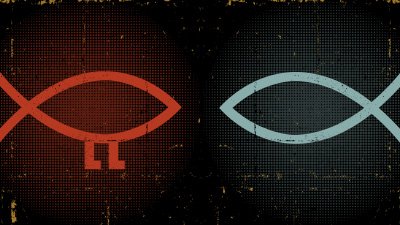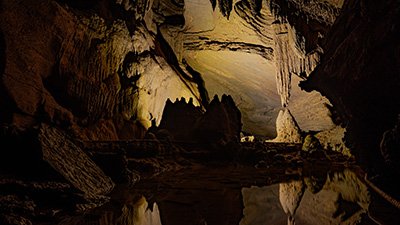Misguided God of the Gaps
Curricula like Integrate accuse biblical creationists of appealing to a “God of the gaps”—yet this charge often forgets humanity’s smallness and the universe’s complexity.
Science is a field of study as old as humanity. It began on the very first day of humanity when Adam named the Animals God presented to him. It has continued as mankind has interacted with God’s creation, seeking to understand and steward everything from minerals to plants to animals. Throughout the 6,000 years of human history, there has been an increasingly sophisticated understanding of the natural world. We could examine various periods of understanding in different fields of study in various parts of the world, but let us particularly look at the last 400 years in the Western world where we see the development of what we know today as the scientific method.
The Christian Foundation of Science
Responding to Compromised Curriculum
As many have explained in detail, the scientific revolution that peaked during the period that we know as the Enlightenment was the result of a worldview that was supremely influenced by Christian thought. Because there is a God who has created the world in an orderly way, we should expect to find order in the systems that operate according to the laws he put in place. To study nature was to seek to uncover and describe the laws that God programmed into his creation, by which he upholds the universe (Genesis 8:22; Hebrews 1:1–4). Johannes Kepler put into words what many of these men (and a handful of women) intended as they studied their selected fields—they were “thinking God’s thoughts after him” in understanding the natural world.
As atheism began to find its place in scientific discussions, they sought to remove any notion of supernatural influence in the study of the natural world.
As atheism began to find its place in scientific discussions, they sought to remove any notion of supernatural influence in the study of the natural world. Materialism and naturalism became an increasingly common way to view science. As a result, these atheists even began to influence the church and its study of nature.1
In 1893, the Scottish evangelist Henry Drummond presented a series of lectures in Boston that was published as The Ascent of Man. He was a proponent of theistic evolution and railed against Christians who would explain away gaps in understanding of the natural world by simply saying God must have done whatever explained away the gap in knowledge:
There are reverent minds who ceaselessly scan the fields of Nature and the books of Science in search of gaps — gaps which they will fill up with God. As if God lived in gaps? What view of Nature or of Truth is theirs whose interest in Science is not in what it can explain but in what it cannot, whose quest is ignorance not knowledge, whose daily dread is that the cloud may lift, and who, as darkness melts from this field or from that, begin to tremble for the place of His abode? What needs altering in such finely jealous souls is at once their view of Nature and of God. Nature is God's writing, and can only tell the truth ; God is light, and in Him is no darkness at all.
If by the accumulation of irresistible evidence we are driven—may not one say permitted—to accept Evolution as God's method in creation, it is a mistaken policy to glory in what it cannot account for. The reason why men grudge to Evolution each of its fresh claims to show how things have been made is the groundless fear that if we discover how they are made we minimize their divinity. When things are known, that is to say, we conceive them as natural, on Man's level ; when they are unknown, we call them divine—as if our ignorance of a thing were the stamp of its divinity. If God is only to be left to the gaps in our knowledge, where shall we be when these gaps are filled up? And if they are never to be filled up, is God only to be found in the disorders of the world? Those who yield to the temptation to reserve a point here and there for special divine interposition are apt to forget that this virtually excludes God from the rest of the process. If God appears periodically, he disappears periodically. If he comes upon the scene at special crises he is absent from the scene in the intervals. "Whether is all-God or occasional-God the nobler theory? Positively, the idea of an immanent God, which is the God of Evolution, is infinitely grander than the occasional wonder-worker who is the God of an old theology. Negatively, the older view is not only the less worthy, but it is discredited by science.2
More recently, U.K. theologian Alister McGrath Alister McGrath also delivered a lecture at the Evolution and Christian Faith Conference that reiterated the idea of a “God of the gaps” approach to understanding the natural world. It was published by BioLogos,3 an organization intent on promoting evolution as God’s method of creation over billions of years. While McGrath encourages his listeners to look at all of nature as God’s grand creation, he does so in a way that misses many of the implications of the fall on the original perfect creation. At one point he calls Christians to consider looking at the world in light of Romans 12:1–2, saying, “It’s a marvelous vision for the Christian mind, not being content with simply buying into what the world tells but in fact saying that there is a better way of seeing the world.” Ironically, that seems exactly what McGrath and BioLogos are calling Christians to do—to accept the world’s explanation for how the universe came to be through the big bang, how the earth formed the geologic evolution, and how life evolved through natural processes with no guiding influence over billions of years.4
Dr. McGrath’s critique seems to be directed against the modern intelligent design movement, led primarily by the Discovery Institute and its various arms.
Dr. McGrath’s critique seems to be directed against the modern intelligent design movement, led primarily by the Discovery Institute and its various arms. As biblical creationists, we have used some of the arguments developed by thinkers like Michael Behe, but we have never made these our primary arguments for the existence of God or the truthfulness of Christianity or the Bible. McGrath asserts:
My own approach is not to retreat into explanatory gaps. There are those who say (and perhaps I caricature or mis-say what they say), “Well, you know, science can’t explain that. But if there were a god, he could. Therefore, what science can’t explain—that is a good reason for believing in God.” And part of me wants to say, “Yes!” to that. But part of me also wants to say, well, this is not a very good idea, and leaves us bereft of the richness of a vision of God. It kind of implies that you believe in God because of the tiny little holes in somebody else’s explanation, which you think you can explain better in brackets—at least for the time being. For me, it’s not about saying, “Oh look! There’s a gap there, and that’s where God comes in!” No, no, no, it’s about the big picture. That is what makes us think that the Christian faith makes sense of things. . . . What I want to do now is move to the topic of the “god of the gaps.” It often says, “Science can’t explain this, but if God exists, this is what you would expect, therefore that shows [but not very clearly] that there is a god.” I think there are all kinds of problems with this. The most obvious one is that scientific advance squeezes gaps until they get smaller. [Emphasis in original.]5
As he acknowledges, the Christian faith is what allows us to make sense of the world. But in order to do so, we must rightly understand how God has worked in the world in the past. And the only way to do that (barring the invention of time travel) is to have reliable eyewitness testimony. McGrath, BioLogos, and the vast majority of those who embrace the intelligent design movement have compromised the beginning chapters of the Bible, seeking to fit billions of years of history into what is plainly six days of creation about 6,000 years ago. They endorse common descent (even within the ID movement) to various degrees or invent periods of special creation in a day-age reimagining of Genesis 1–2. With these flawed understandings of creation, sin, the fall, and the impacts on all of the universe (Romans 8:22), they misinterpret the evidence we have in the present as we try to understand what happened in the past. McGrath would have us follow a program of natural theology, allowing science without God in the laboratory, as it were, to tell us how things operate in the natural world while using the Bible to tell us of the big picture of reality and the connection between science and religion. But what he and the BioLogos proponents fail to realize is that evolutionary views invoke a god to fill in the gaps of what initiated the big bang, where the first stars came from, and how the first living organism formed on earth. They take those events on faith, telling us that science (rather than God) can explain the gaps . . . just not yet.
But can scientists really squeeze God out of all of those gaps?
Confusing the Past and Present
BioLogos attempts to explain this apparent failure in another article using Isaac Newton as an example.6 As Newton observed and calculated the motion of the planets within our solar system, he assumed that their “gravitational perturbations would accumulate and slowly disrupt the magnificent order of the solar system. To counteract these and other disruptive forces, Newton suggested that God must necessarily intervene occasionally to tune up the solar system and restore the order.” So God would have to give the planets a nudge here and there to make the “gaps” in Newton’s model work. As more data was analyzed with observable, repeatable, and testable processes, it was understood that the forces wind up balancing themselves out. But this is an example of operational science correcting itself over time. Newton was shown to be wrong, but that does not mean that God was not, or is not, involved in the operation of the planets; nor does it negate Genesis 1:14–19 or Colossians 1:17.
The second example from Newton involves the structure and function of the solar system. Newton’s theory of motion was compatible with any arrangement of planets, but he believed the orderly and similar pattern could not be explained by “mere mechanical causes” that could “give birth to so many regular motions, ” saying, “This most beautiful System of the Sun, Planets, and Comets, could only proceed from the counsel and dominion of an intelligent and powerful Being.” The BioLogos article goes on to claim,
We now know that Newton was wrong. . . . Newton had no concept of how solar systems could form on their own or what the planetary motions would be like in naturally forming systems. Astronomy simply had not developed to this point. In the decades after Newton, astronomers discovered that solar systems form naturally from large clouds of rotating matter. Therefore, a large, slowly rotating cloud collapses under its own gravity, and it tends to flatten into something like a pancake. Saturn’s rings are an interesting example where the cloud is still present. The material collects into big clumps in the plane of the pancake. After the process is completed, a collection of clumps all traveling in the same direction and in the same plane exists—just like our solar system.7
And when we bring the Bible in as evidence, as it rightly is God’s eyewitness account of his own creation, we understand that God created the solar system on day four of creation week within 24 hours, not over billions of years.
But are these two claims equivalent? Has the formation of a solar system been observed in observable, repeatable, and testable processes? The answer is no. And indeed, this idea is still referred to as the nebular hypothesis or solar nebular model. But this is an example of origins or historical science. In this case, Newton has not been proven wrong—modern scientists have asserted that Newton is wrong based on their own materialistic models that exclude God a priori. And when we bring the Bible in as evidence, as it rightly is God’s eyewitness account of his own creation, we understand that God created the solar system on day four of creation week within 24 hours, not over billions of years.
Filling in the Gaps
As we seek to understand the world that God has created, we are finite creatures seeking to understand the infinite, triune Creator. We are each a drop of water attempting to explore the oceans on every planet in the universe. As we use the minds that God gave us to study and understand his creation, we will regularly encounter things we do not understand. When we do, the right question to ask is how and why God did it that way. We may be able to unravel the answers to many of those questions in time. For some gaps, we may never know, but we can always wonder what God was thinking when he did it that way—and this is thinking God’s thoughts after him: a continual, noble pursuit (Romans 11:33). The utter complexity and obvious design from the subatomic particles to the grand scale of the universe is evidence that there is a Creator whose eternal power and divine nature are clearly seen in the creation that he both created and is constantly upholding (Colossians 1:15–20).
As we wonder, we do so in awe of a God who is infinite yet cares for rebellious mankind enough to step into his own cursed creation to redeem us from our sin and give us a place with him for eternity (Ephesians 4:2–7).
Footnotes
- See Terry Mortenson, The Great Turning Point: The Church’s Catastrophic Mistake on Geology — Before Darwin, Green Forest, AR: Master Books, 2004.
- J. Henry Drummond, The Ascent of Man (NY: Pott & Co., 1908), 332–333, https://archive.org/details/lowelllecture00drumiala/mode/2up.
- Alister McGrath, “Big Picture or Big Gaps? Why Natural Theology Is Better than Intelligent Design,” BioLogos, September 15, 2014, https://biologos.org/articles/big-picture-or-big-gaps-why-natural-theology-is-better-than-intelligent-design.
- See Roger Patterson, “What About Theistic Evolution?” Answers in Genesis, September 13, 2016, https://answersingenesis.org/theistic-evolution/what-about-theistic-evolution/.
- McGrath, “Big Picture or Big Gaps?”
- “Are Gaps in Scientific Knowledge Evidence for God?,” https://biologos.org/common-questions/are-gaps-in-scientific-knowledge-evidence-for-god.
- McGrath, “Big Picture or Big Gaps?”
Recommended Resources

Answers in Genesis is an apologetics ministry, dedicated to helping Christians defend their faith and proclaim the good news of Jesus Christ.
- Customer Service 800.778.3390
- Available Monday–Friday | 9 AM–5 PM ET
- © 2025 Answers in Genesis






